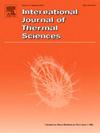Effect of intercell spacing and operating conditions on the performance of prismatic lithium-ion batteries cooled by dielectric immersion Fluids:A numerical study
IF 4.9
2区 工程技术
Q1 ENGINEERING, MECHANICAL
International Journal of Thermal Sciences
Pub Date : 2025-01-08
DOI:10.1016/j.ijthermalsci.2025.109680
引用次数: 0
Abstract
Optimizing lithium-ion battery (LIB) packs for electric vehicles requires balancing the need to increase volumetric energy density with the necessity of effective thermal management to ensure performance and safety. Recently, the prismatic cell form-factor has enabled the cell-to-pack approach which increases the battery pack energy density. Additionally, dielectric fluid immersion cooling (DFIC) has emerged as a promising battery thermal management (BTM) technology. This article investigates the effectiveness of DFIC's in managing the thermal performance of modules composed of prismatic lithium-ion cells. Specifically, the influence of intercell spacing on cells' temperature, pressure drop across a module, and the volumetric energy density of the module was investigated. The electrochemical-thermal performance of cells at different mass flow rates of the coolant, coolant types, rates of discharge, and the resting time between a charge and a discharge was assessed. The single-particle electrochemical-thermal model has been used to model the performance of the batteries. The model results show that DFIC can maintain the maximum temperature and maximum temperature difference of a cell within 25–40 °C and 0–5 °C, respectively, even when the distance between cells is < 1.0 mm and at <10 g/min. By reducing the intercell spacing, the volumetric energy density increases by 8.33 %. At 0.25 mm with mineral oil coolant, the pumping energy accounts for only 0.00185 % of the module's total energy per cycle. Among the coolants studied, deionized water gave better overall performance. This study shows that DFIC is viable BTM technology for high-energy and high-power battery packs.
求助全文
约1分钟内获得全文
求助全文
来源期刊

International Journal of Thermal Sciences
工程技术-工程:机械
CiteScore
8.10
自引率
11.10%
发文量
531
审稿时长
55 days
期刊介绍:
The International Journal of Thermal Sciences is a journal devoted to the publication of fundamental studies on the physics of transfer processes in general, with an emphasis on thermal aspects and also applied research on various processes, energy systems and the environment. Articles are published in English and French, and are subject to peer review.
The fundamental subjects considered within the scope of the journal are:
* Heat and relevant mass transfer at all scales (nano, micro and macro) and in all types of material (heterogeneous, composites, biological,...) and fluid flow
* Forced, natural or mixed convection in reactive or non-reactive media
* Single or multi–phase fluid flow with or without phase change
* Near–and far–field radiative heat transfer
* Combined modes of heat transfer in complex systems (for example, plasmas, biological, geological,...)
* Multiscale modelling
The applied research topics include:
* Heat exchangers, heat pipes, cooling processes
* Transport phenomena taking place in industrial processes (chemical, food and agricultural, metallurgical, space and aeronautical, automobile industries)
* Nano–and micro–technology for energy, space, biosystems and devices
* Heat transport analysis in advanced systems
* Impact of energy–related processes on environment, and emerging energy systems
The study of thermophysical properties of materials and fluids, thermal measurement techniques, inverse methods, and the developments of experimental methods are within the scope of the International Journal of Thermal Sciences which also covers the modelling, and numerical methods applied to thermal transfer.
 求助内容:
求助内容: 应助结果提醒方式:
应助结果提醒方式:


